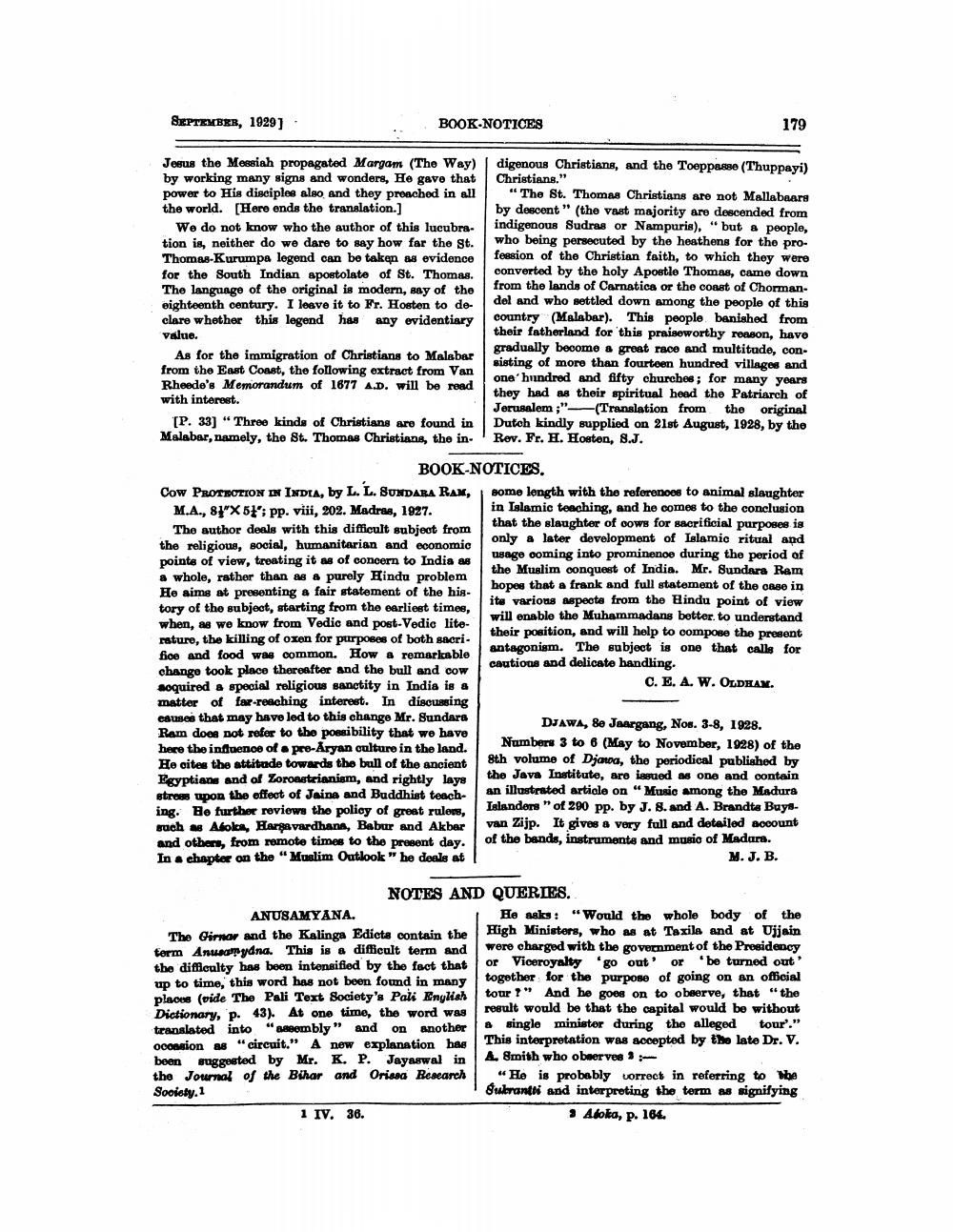________________
SEPTEMBER, 1929]
BOOK-NOTICES
179
Jerus the Messiah propagated Margam (The Way) by working many signs and wonders, He gave that power to His disciples also and they proached in all the world. [Here ends the translation.]
We do not know who the author of this lucubration is, neither do we dare to say how far the St. Thomas-Kurumpa legend can be taken as evidence for the South Indian apostolato of St. Thomas. The language of the original is modern, say of the eighteenth century. I leave it to Fr. Hoston to declare whether this legend has any evidentiary value.
As for the immigration of Christians to Malabar from the East Coast, the following extract from Van Rheede's Memorandum of 1677 A.D. will be read with interest.
[P. 33) "Three kinds of Christians are found in Malabar, namely, the St. Thomas Christians, the in.
digenous Christians, and the Toeppasse (Thuppayi) Christians."
"The St. Thomas Christians are not Mallabaars by descent" (the vast majority are descended from indigenous Sudras or Nampuris), “but & people, who being persecuted by the heathens for the profession of the Christian faith, to which they were converted by the holy Apostle Thomas, came down from the lands of Carnatica or the coast of Chormandel and who settled down among the people of this country (Malabar). This people banished from their fatherland for this praisoworthy reason, have gradually become a great race and multitude, consisting of more than fourteen hundred villages and one' hundred and fifty churches: for many years they had as their spiritual head the Patriarch of Jerusalem;" (Translation from the original Dutoh kindly supplied on 21st August, 1928, by the Rev. Fr. H. Hoston, S.J.
BOOK-NOTICES. Cow PROTECTION IN INDIA, by L. L. SUNDARA RAM, some length with the referenoes to animal slaughter
M.A., 81"X 51': pp. viii, 202. Madras, 1927. in Islamic teaching, and he comes to the conclusion The author deals with this difficult subject from
that the slaughter of cows for sacrificial purposes is the religious, social, humanitarian and economic
only & later development of Islamic ritual and points of view, treating it as of concern to India as
usage ooming into prominenoe during the period of a whole, rather than as & purely Hindu problem
the Muslim conquest of India. Mr. Sundara Rem
hopes that a frank and full statement of the case in He aims at presenting a fair statement of the hig
ite various aspects from the Hindu point of view tory of the subject, starting from the earliest times,
will enable the Muhammadans better to understand when, as we know from Vedic and post-Vedio lite
their position, and will help to compose the present rature, the killing of oxen for purposes of both sacri. fice and food was common. How a remarkable
antagonism. The subject is one that calls for
cautious and delicate handling. change took place thereafter and the bull and cow aoquired a special religious sanctity in India is a
C.E. A. W. OLDHAN. matter of far-reaching interest. In discussing eauses that may have led to this change Mr. Sundara
DJAWA, 80 Jaargang, Nos. 3-8, 1928. Ram does not refer to the possibility that we have here the influence of a pro-Aryan culture in the land.
Numbers 3 to 6 (May to November, 1928) of the He cites the attitude towards the ball of the ancient
8th volume of Djawa, the periodical published by Egyptians and of Zoroastrianism, and rightly lays
the Java Institute, are issued as one and contain stress upon the effect of Jains and Buddhist teach
an illustrated article on " Music among the Madura ing. He further reviews the policy of great rulons,
Islanders" of 290 pp. by J. 8. and A. Brandts Bays. such as Adolom, Harga vardhana, Babur and Akbarvan Zijp. It gives a very full and detailed account and others, from remote times to the present day. I of the bands, instruments and musio of Madara. In a chapter on the "Muslim Outlook" he deals at !
M.J. B.
NOTES AND QUERIES. ANUSAMYANA.
1 He asks: “Would the whole body of the The Qirnox and the Kalinga Edicta contain the High Ministers, who as at Taxila and at Ujjain term Anusamydna. This is a difficult term and were charged with the government of the Presidency the diffeulty has been intensified by the fact that or Viceroyalty 'go out' or 'be turned out up to time, this word has not been found in many together for the purpose of going on an official places (vide The Pali Text Society's Pali English tour ?" And he goes on to observe, that "the Dictionary, p. 43). At one time, the word was
result would be that the capital would be without translated into "asteembly" and on another & single minister during the alleged tour'." oconsion as "circuit." A new explanation has This interpretation was accepted by the late Dr. V. been suggested by Mr. K. P. Jayaswal in 4. Smith who obmerves :the Journal of the Bihar and Orissa Research "He is probably correct in referring to the Sooloty. 1
Skranthi and interpreting the term as signifying 1 IV. 36.
3 Aboka, p. 164




